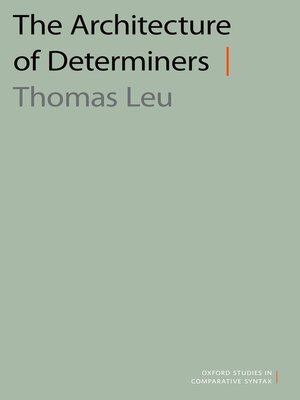
Sign up to save your library
With an OverDrive account, you can save your favorite libraries for at-a-glance information about availability. Find out more about OverDrive accounts.
Find this title in Libby, the library reading app by OverDrive.



Search for a digital library with this title
Title found at these libraries:
| Library Name | Distance |
|---|---|
| Loading... |
Work in morphology is typically concerned with productive word formation and regular inflection, in any event with open class categories such as verbs, nouns, and adjectives, and their various forms. The Architecture of Determiners, by contrast, is devoted to a set of function words: the closed class of determiners. While it is traditionally assumed that function words are syntactically atomic, Thomas Leu shows that a comparative perspective on a series of determiners - each insistently vivisected into its minimal morphotactic segments - reveals an anatomy with properties analogous to clausal syntax, including a lexical, an inflectional, and left peripheral layer, as well as transformational relations among subconstituents. Leu argues that determiners are extended adjectival projections with a closed class minimal stem. Leu focuses on Swiss German and German, using other Germanic and non-Germanic languages as a comparative domain. His discussion of the internal structure of determiners includes demonstratives (ch.2), distributive quantifiers (ch.4), possessive and negative determiners (ch.5), and interrogative determiners such as 'was für' (ch.6). His main claim - that all of these involve extended adjectival projections - connects naturally to a discussion of adjectival / determiner inflection in German. Chapter 3 addresses the oft-debated strong versus weak agreement alternation in a novel way, proposing that the adjective moves within its own extended projection, in a way akin to verb movement to C in the clause. This accounts for the central facts of nominative and accusative inflection. Chapter 7, then, addresses dative and genitive morphology, setting them syntactically apart from adjectival / determiner inflection in a way that leads to a surprising account of most of the systematic (meta-) syncretism patterns in German adjectival inflection.







